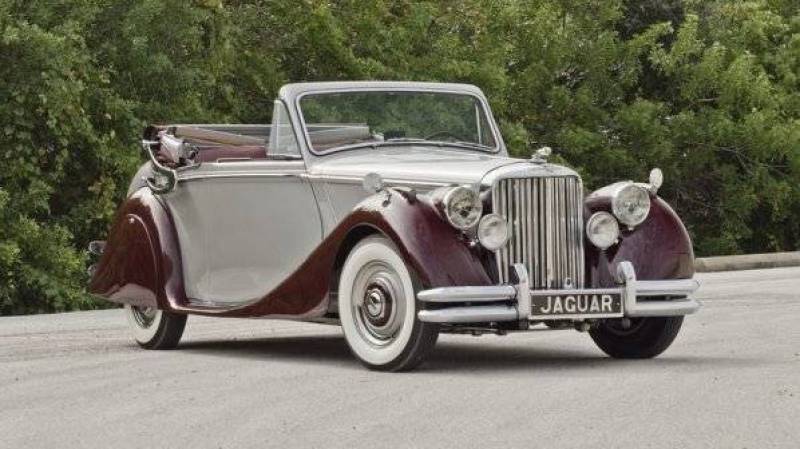Jaguar Mark V Drop Head Coupe
Production: 1948 - 1951
Production Type: Mass Production
Produced: 1001
The Jaguar Mk V Drop Head Coupe is a model in the still popular folding roof body based on 2.5 and 3.5 liter engines.

About Jaguar Mark V Drop Head Coupe
Together with the Jaguar Mk V Saloon, the Jaguar Mk V Drop Head Coupe was presented to the press and distributors on September 30, 1948, and only almost a month later, on October 27, was officially shown at the London Motor Show.
The production of the car was based on the already beloved 2.5 (which was partially redesigned) and 3.5 liter engines. Although the sports model Jaguar XK120 with the new XK engine was already announced , it was not put on the “classic” Mk V models. considered them to be quite conservative.
The production of models ended in 1951 when the new Jaguar Mark VII model came to replace . During the existence of the model, ~1,001 cars were manufactured in the DHC body, of which ~ 29 per 2.5 liters (right-hand drive - 17, left-hand drive - 12) and ~ 972 per 3.5 liters (right-hand drive - 395, left-hand drive - 577).
Jaguar Mark V Drop Head Coupe Overview
The car was in many ways similar to the Jaguar IV DHC , but there were enough differences: changed and improved body lines, a new front suspension, main light lamps built into the fenders, etc.
Jaguar Mark V Drop Head Coupe Technical Specification
Engine:
2.5 Liter: 2663 c.c.; 6 cylinders; Cylinder diameter and piston stroke - 73 × 106 mm; Two S.U. carburetor; 103 HP (~70 kW).
3.5 Liter: 3485 c.c.; 6 cylinders; Cylinder diameter and piston stroke - 82 × 110 mm; Two S.U. carburetor; 125 HP (~93 kW).
Removable cylinder head made of chromium iron, Tecalemit oil filter, compression ratio 7:75, 7-bearing crankshaft, two SU carburettors, submersible oil pump, light alloy connecting rods Lucas de Luxe ignitions, forced lubrication system, aluminum pistons, twin exhaust system with Burgess mufflers, pump cooling with thermostat.
Gearbox: Synchronized four-speed gearbox.
Gear ratios: 1at - 14.5, 2at - 8.52, 3at - 5.87, top - 4.3.
Frame: Steel frame of increased rigidity. Stability in sharp turns is ensured by special fasteners.
Suspension: Front suspension - independent, wishbone and torsion bar. Rear suspension - with transverse springs made of silicon-manganese steel controlled by Girling PV.7 (hydraulic dampers). Hydraulic shock absorbers.
Brakes: Millenite drums with integrated vents and two pads. Rear wheel hand brake.
Wheels and tires: Forged wheels with Dunlop 6.70×16 tires.
Spare and tools: The spare wheel is hidden in a special compartment at the rear of the car. Tools in a drawer in the trunk area with automatically controlled lighting.
Gas Equipment: 14 gallon gas tank with rear fender filler. Two electric pumps.
Electrical equipment: Lucas de Luxe electronics kit, 12 volts. 64 amp battery (discharge in 10 hours), windshield wipers, built-in main and fender lamps, two fog lamps, brake lamps, cigarette lighter, air conditioning and heating system, dual horn, reversing light, tail lamps, two interior lamps controlled by doors.
Controls: Burman steering gear with screw and ball nut. Bluemel steering wheel.
Dashboard: Speedometer at 120 mph, water temperature gauge (engine cooling), emergency light switch, rpm gauge, oil pressure gauge, ammeter, clock, fuel gauge.
Finishes: "Dunlopillo" and "Vaumol". Floor with felt backing. Leather pockets with locks on the doors. Wooden elements are made of polished walnut wood. Roomy trunk. Windows with ventilation.
Seats: Front seats with adjustable height and depth. Rear seats with hidden drop down armrest.
Jacking: Special jacks provide easy wheel lifting in 10 seconds.
Trunk: Roomy trunk in the rear of the car.
Dimensions: Length 15′ 7″, width 5′ 8 1/2″, height 5′ 2 1/2″, unloaded turntable 37′ 0″.
Weight: - 32 cwt / 1626 kg.
Wheelbase: 10′ 0″, front track 4′ 8″, rear track 4′ 9 1/2″.
Colours: The Jaguar Mk V Drop Head Coupe was available in 59 colours. See the 1949 Jaguar catalog on page 19 for a complete list.
Price: Reliable information could not be found.